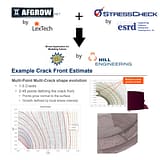Altair Innovation Intelligence Publishes a S.A.F.E.R. Simulation Primer
Last week, ESRD wrote a guest contribution for Altair’s Innovation Intelligence blog titled “Hyper-Fidelity Structural Analysis for S.A.F.E.R. Numerical Simulation...
Last week, ESRD wrote a guest contribution for Altair’s Innovation Intelligence blog titled “Hyper-Fidelity Structural Analysis for S.A.F.E.R. Numerical Simulation...

Want to learn from the experts in FEA-based Simulation Application (Sim App) development for standardization & automation of complex engineering analysis tasks, such as 3D fatigue crack growth, 3D ply-by-ply laminated composite analysis or other challenging applications you’d like to safely put into the hands of non-experts?
This July, ESRD will be partnering with several industry leaders to provide not one but TWO stimulating webinars on the latest in FEA-based Sim App development.

Hill Engineering and ESRD have executed a joint marketing agreement to collaboratively promote the combined use of our software tools Broad Application for Modeling Failure (BAMF) and StressCheck Professional, respectively, for the engineering applications of fatigue and damage tolerance analysis.

In early 2020 ESRD rolled out v2.0 of the StressCheck User Experience survey, and the results have been tallied! Find out what features & applications your peers want to see in a future StressCheck release.

ESRD is pleased to join Hill Engineering, LLC (developers of BAMF) and LexTech, Inc. (developers of AFGROW) for a joint webinar on July 17, 2019 @ 1:00 pm EST.
This collaborative webinar will be titled “3D Crack Growth Simulation: Advancements & Applications”, and will detail the latest technological advancements for accurate simulation of three-dimensional metallic crack growth via coupled finite element analysis (FEA) and fatigue life computations.

In the October 2018 issue of NAFEMS Benchmark magazine, ESRD Chairman Dr. Barna Szabó posed a new “FEA Puzzler”: Can you determine the progression in spring rate as a 3D coil spring is deformed? And, can you verify the accuracy of your solution? Give it your best shot!

In this 15-minute pre-recorded webinar, ESRD Chairman Dr. Barna Szabó addresses some of the key issues of simulation governance, including how model development must adhere to the requirements of simulation governance in order to minimize risk and increase reliability.

A new Simulation Governance (SimGov)-oriented article by ESRD’s Dr. Barna Szabo and Dr. Ricardo Actis, titled “Planning for Simulation Governance and Management – Ensuring Simulation is an Asset, not a Liability”, is available to read in the July 2021 issue of NAFEMS Benchmark magazine.

While this past year presented unique challenges and unprecedented disturbances, we hope that you found our customer support, on-demand webinars, web-based training services and overall experience with our team to be refreshingly positive. Click to see a special message from ESRD!

With the release of StressCheck v11 in December 2020, ESRD unveiled a significantly improved user interface experience, a voluminous online documentation portal, and a re-written Getting Started Guide with a companion video tutorial. In addition, we’ve revamped our Getting Started page, with helpful links for member registration, licensing & installation, the basics of StressCheck usage, and other key links & resources. In short, it’s never been easier to learn StressCheck!
“A screening of existent commercial and non-commercial tools was carried out in respect to their fracture mechanics capabilities, their design abilities, implementation as well as their complexity. Although, there are many software possibilities, only those within the reach of the author were evaluated. This resulted in the selection of the commercial tool StressCheck. The assessment of crack propagation on compact tension and two stringer specimens governed by the Paris and Forman regimes was satisfactory compared with experimental results using the material data from simple standard specimens.”
© 2025 · Engineering Software Research & Development, Inc. | Terms & Conditions | Privacy & Cookie Policy | Software License Agreement | Software Maintenance and Technical Support Policy